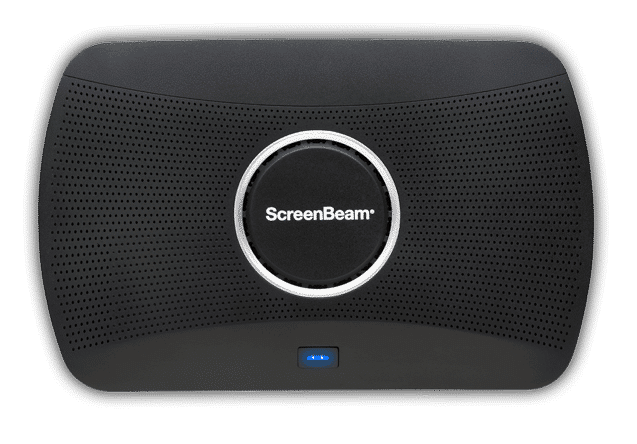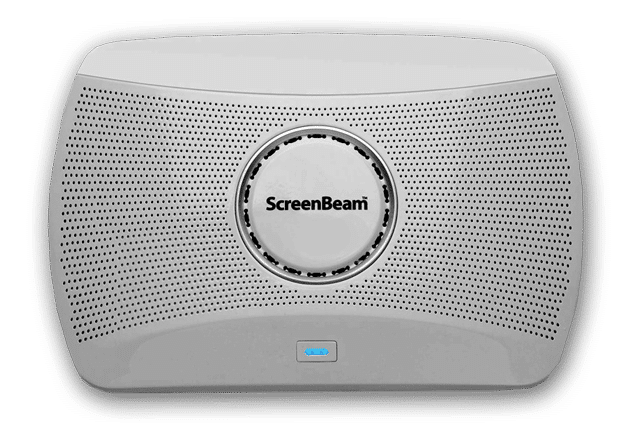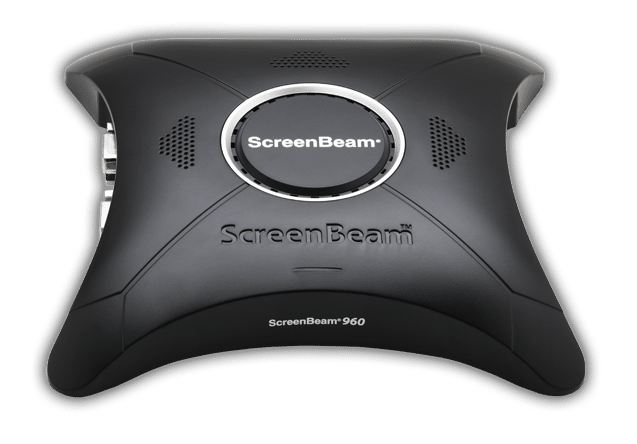Miracast™ Transforms Conference Rooms
Flexible, high-performing wireless presentation and Unified Communications platform enabling hybrid meeting spaces.
What is Miracast?
Miracast is an industry standard that allows you to display what’s on your device on a larger screen. For example, you want to give a presentation with images and audio in a conference room. Instead of finding the necessary cables and tethering your laptop to the display, you can wirelessly mirror your screen. Miracast is different from a standard wireless network that covers a whole home, office, or building, in that the connection is simply one device communicating directly with another without requiring wired or wireless network infrastructure.
Miracast has been described as a wireless video HDMI® cable connection without the cable. Enhanced functionality can be gained by using ScreenBeam Wireless Display technology, allowing users to fully interact with each other and the displayed content. Because Miracast has been natively integrated into modern Windows platforms, including Windows 11, users can share content wirelessly, treat the display in a variety of ways, including extended display, and take full advantage of Microsoft 365 features, including touch screen support and inking without the need of addition software applications.

Miracast is defined and continues to be maintained by the Wi-Fi Alliance (the industry standards body for Wi-Fi technologies). ScreenBeam, as an active member of the Wi-Fi Alliance, played a key role in the creation of the Miracast standard and ScreenBeam is also a key partner in Microsoft’s implementation of Miracast in Microsoft Windows operating systems and Microsoft 365.
Which Devices Use Miracast?
Miracast comes enabled on a variety of wireless devices. It’s native with modern Windows devices including Windows 11 and Android 4.2 or Android 5 devices. This means that millions of devices are ready for Miracast out of the box. You can see a complete list of Wi-Fi Alliance’s Wi-Fi CERTIFIED devices that work with Miracast. It’s native with modern Windows devices including Windows 11. It’s also supported in Android 4.2 and Android 5 devices.

Top Four Benefits of Miracast in Modern Conference Rooms
1. Miracast Makes Connectivity Issues a Thing of the Past
We’ve all been there. You’re about to give an important presentation and everyone’s looking at you. They all want to hear what you have to say, but nobody has time to waste. Then you realize that the cable you brought to connect your laptop to the meeting room’s display doesn’t fit. You scramble to find the right cable, but your audience is losing focus.
With Miracast, users don’t waste time looking for the right cable. They seamlessly connect devices to displays, and switch from one presenter to another, increasing productivity while cutting setup time. This eliminates time lags that cut into the first few minutes of your meetings because of compatibility issues. Miracast doesn’t require Wi-Fi to establish a connection. You don’t have to worry about network slowdowns, even when displaying video, and your IT department doesn’t have to worry about any extra strain on the network.

2. Miracast Untethers Presenters
Moving around the room is a must with today’s presentations. Professional speakers and teachers frequently move around for several reasons. First, it feels more natural to walk around than to stand tethered to a computer or podium. Second, the movement helps hold the audience’s attention and helps them remember more of the information later. Third, a speaker who moves about seems more like they’re engaging with the audience than lecturing, building rapport and fostering interaction.
With wireless mirroring, presenters aren’t tied down by cables. They can now move as they desire. Important sales pitches, strategy sessions, and more take on new life when speakers are free to move naturally and interact with their colleagues.

3. Miracast Boosts Team Collaboration During Working Sessions
Increasingly, companies are removing whiteboards from their conference rooms and installing interactive touch displays. These displays are great for collaboration. Many teams take things a step further by using ScreenBeam’s screen-mirroring technology, which allows Miracast devices to fully interact with touch displays. ScreenBeam’s patented Ghost Inking technology further enhances touch screen interactivity making the experience far more intuitive and accurate.
Miracast helps presenters replace the tired one-to-many lecture with interactive discussions, inspiring everyone to contribute their thoughts and ideas. Users can share notes, images, and annotations easily, and everyone can have a copy right away. When the team is constantly connected, they can strike an optimal workflow much more easily.

4. Miracast Is Native to Windows
One of the first questions businesses ask when they consider adopting a new technology is how much it will cost to upgrade their systems. The beauty of Miracast is that it’s native to Windows 11 and 10. With more than 500 million active machines currently running Windows 11, there are a ton of devices already compatible with this technology.
Because Miracast doesn’t have to rely on a wireless network to display content, users can rest assured that sensitive material is kept secure. This focus on safeguarding information makes ScreenBeam the ideal wireless display solution for industries with stringent security standards from large-scale financial institutions to small medical offices.
Using Miracast with Windows devices comes with a huge bonus: With collaborative tools like Microsoft Teams Rooms and Windows Ink, the productivity of working sessions is elevated. Now, sharing is so much more than emailing the PowerPoint presentation to everyone after the meeting. Team members can share screenshots, annotations, and data instantly and wirelessly.

Miracast and ScreenBeam Together Encourages Time Saving, Collaboration, and Compatibility
Not all Miracast-enabled products are the same. Many consumer devices rely on the most basic implementation of the Miracast specification typically featuring simple radios and consumer-grade components. The result can be frustrating undesired experiences, such as lag, pixelation, and random disconnections. Technology should just work and not leave end-users unhappy and dis-satisfied.
ScreenBeam’s receivers are designed specifically for the challenges of enterprise and education environments, where secure wired and wireless networking and device density are the most difficult. Multiple radios, antennas, enterprise-class componentry, and embedded technology in ScreenBeam’s receivers provide Miracast the best possible path to ensure a reliable, secure, and stable operation. This gives end-users the easiest wireless presentation and interactive display experience of any solution in the marketplace while addressing IT’s strenuous security, implementation, management, and reliability requirements.
The benefits of working together with the aid of Miracast and ScreenBeam Wireless Display technology mean a lot in today’s fast-paced business environment. When they don’t have to find cords, get everyone on the Wi-Fi, or hand out paper notes, your team can spend more time doing what they do best. When they can move around the room to maximize collaboration and engagement, your team can be more productive. This technology is a simple way to transform your conference room into a place where great things happen.
SB1100 Plus
Flexible, high-performing wireless presentation and UC platform enabling hybrid meeting and learning spaces.
SB1000 EDU
Specifically for K-12 Environments. 4K App-Free Wireless Screen Sharing and Annotation on Any Teacher Device.
SB960
Designed for small businesses to enable hassle-free wireless presentation and collaboration from Windows, Android and Apple devices.


